
Deposition Date
2010-09-29
Release Date
2010-10-20
Last Version Date
2023-11-01
Entry Detail
PDB ID:
3P0N
Keywords:
Title:
Human Tankyrase 2 - Catalytic PARP domain in complex with an inhibitor
Biological Source:
Source Organism:
Homo sapiens (Taxon ID: 9606)
Host Organism:
Method Details:
Experimental Method:
Resolution:
1.90 Å
R-Value Free:
0.19
R-Value Work:
0.15
R-Value Observed:
0.16
Space Group:
C 2 2 21


